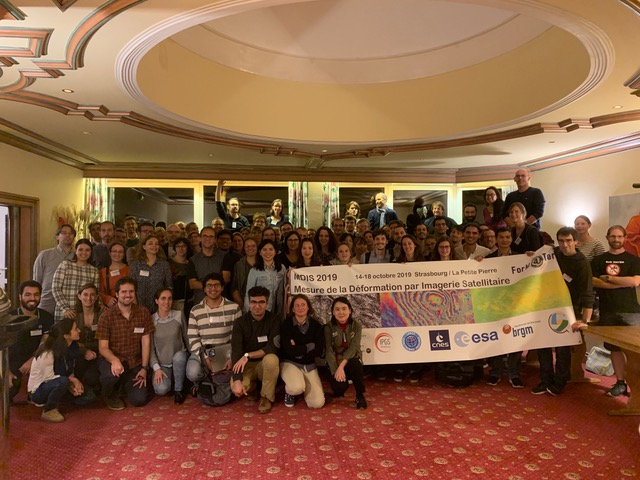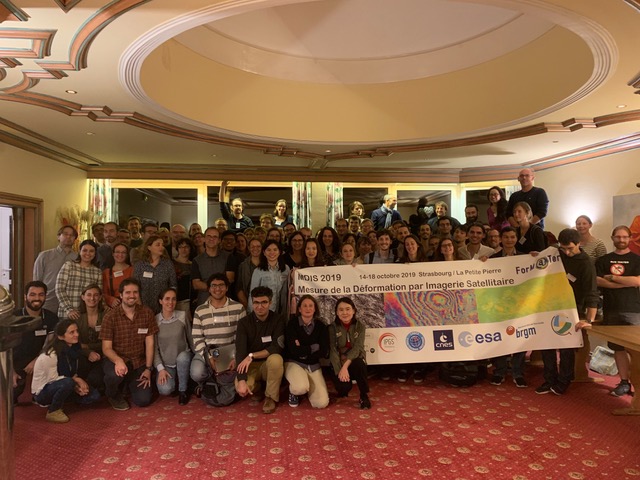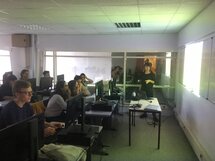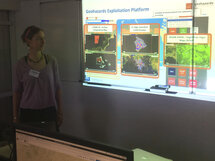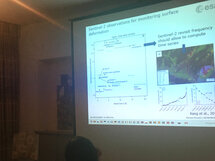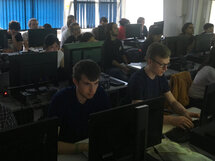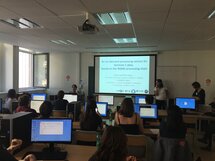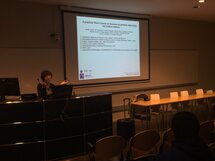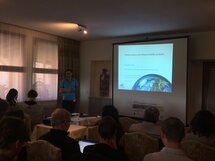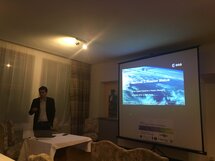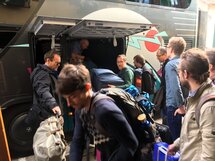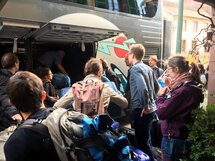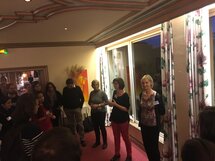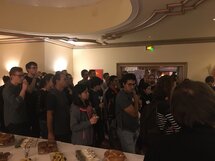

From 14th to 18th October 2019, EOST and IPGS hosted the MDIS-2019 training course and conference. The conference addresses experts in satellite and GNSS data processing for earth surface deformation analysis, in signal processing and in Big Data mining and information retrieval, The objectives were to share fundamental and practical knowledge, to develop new perspectives and to coordinate structuring actions with international institutions. 95 participants from nearly 15 countries attended the event. MDIS-2019 was supported by CNRS/ForM@Ter, CNES, ESA, BRGM and University of Strasbourg/LabEX G-Eau-Thermie.
Programme
monday 14 October 2019
- Class1: The on-demand NSBAS processing chain - Cécile Lasserre, Erwan Pathier, Marie-Pierre Doin & Franck Thollard
- Class2: The on-demand SNAP-StaMPS PSI processing chain - Michaelis Foumelis
- Class3: SAR imagery processing with the Orfeo Toolbox / OTB - Philippe Durand & Victor Poughon
tuesday 15 October 2019
- Class4: Optical processing services for quantifying Earth surface deformation: the MPIC, DSM-OPT and ALADIM processing chains - Aline Déprez, Floriane Provost, David Michéa & Jean-Philippe Malet
- Class5: The Geohazards Exploitation Platform in a nutshell - Fabrice Brito & Floriane Provost
- Class6: Computing and mining displacement times series - Yajing Yan, Nicolas Méger, Flavien Vernier, Christophe Rigotti, Catherine Pothier & Emmanuel Trouvé
wednesday 16 October 2019
- Class7: DEFVOLC - Interface for the inversion of volcanic deformation sources - Valérie Cayol & Farshid Dabaghi
- Class8: CSI - a Python module to set up fault slip inversions - Romain Jolivet & Zacharie Duputel
Session 1: Satellite signal processing for information retrieval
- Closure phases and biases in InSAR products - Francesco De Zan (DLR - invited speaker)
- Random walk and bias in INSAR time series of Sentinel-1 data associated with decorrelation: impact on ground deformation measurements and mitigation. - Marie-Pierre Doin (ISTerre)
- An algorithm for automatic phase unwrapping errors correction : PhaCo - Béatrice Puyssegur (CEA)
- Gap-filling of InSAR displacement time series - Alexandre Hippert-Ferrer (LISTIC)
- Coherence change detection matrix for change analysis from repeat-pass SAR images: A case study for volcanic eruption monitoring and forest fire damage assessment - Thu Trang Le (LMV)
Round table - Issues in the topographic modelling of the Earth surface
- Catherine Proy (CNES) - Survey about DSM generation from Pléiades
- Yann Klinger (IPGP) - Image correlation for tectonic applications
- Jean-Philippe Malet (EOST) - Towards on-line services for DSM creation
- Laurent Boisnard (CNES) - Opportunities of the CO3D satellite mission and downstream program
Keynote lecture: Copernicus Sentinel-2 mission status - Ferran Gascon (ESA/Esrin)
thursday 17 october 2019
Session 2a: Geophysical interpretation of the deformation I
- What have we learned about faults from three decades of tectonic InSAR? - Tim Wright (Univ. Leeds - invited speaker)
- The temporal variability of aseismic slip along the San Andreas Fault - Sylvain Michel (ENS/Paris)
- Separating transient tectonic signal from atmospheric signal in InSAR time-series, the case of the 2017-2018 slow slip event in Guerrero (Mexico) - Louise Maubant (ISTerre)
- Long-term deformation transients and their possible relation with subduction earthquakes - Anne Socquet (ISTerre)
- Surface deformation during the 2018-19 Mayotte seismo-volcanic crisis from GNSS, synthetic aperture radar and seafloor geodesy - Raphaël Grandin (IPGP)
- The December 2018 eruption of Ambrym volcano: Constraints on the magma plumbing system through the joint analysis of remote sensing, seismicity, and field observations - Tara Shreve (IPGP)
- Transient ground deformation in silicic volcanoes imaged with InSAR: evidence for episodic magma injection at Cordon Caulle and Yellowstone volcanoes - Francisco Delgado (IPGP)
- Using multi-sensor data to characterise the dynamic of magmatic systems along the East African Rift - Fabien Albino (Univ. Bristol)
- Combining InSAR and GNSS to model magma transport during the May 2016 eruption of Piton de la Fournaise Volcano (La Réunion Island) - Delphine Smittarello (Univ. Chambéry)
- Insight on the magma shallow plumbing system of Volcán de Colima, Mexico and its physical properties, from remote sensing - Virginie Pinel (Univ. Chambéry)
Session 2b: Geophysical interpretation of the deformation II
- Status and challenges for monitoring ice motion and deformation with satellite constellations. - Ludivine Libert (ENVEO - invited speaker)
- Long-term ground subsidence of the permafrost basins of the Tibetan plateau revealed by 16-years of ESA SAR missions. - Simon Daout (Univ. Oxford)
- Grounding zone mapping in Antarctica using radar interferometry - Laurane Charrier (Univ. of California)
- Dynamics of slow-moving landslides from dense InSAR time series: insights from a tropical urban environment. - Antoine Dille (RMCA - invited speaker)
- Rapid detection of triggered landslides using satellite radar coherence - Katy Burrows (Durham Univ.)
- A generic machine learning algorithm for land surface mapping - Aline Deprez (A2S - Strasbourg)
- What do we learn from storm-induced landslide inventories from space? The role of total rainfall, landscape steepness and extreme climatology - Odin Marc (GET)
- Exploiting the Sentinel-2 archive for Earth Surface Deformation monitoring. - Floriane Provost (ESA/Esrin)
- Measuring earth surface deformation, glacier dynamics and geomorphic changes from times series of optical satellite images with COSI-Corr - Saif Aati (CalTech)
Session 2c: Geophysical interpretation of the deformation III
- InSAR for reservoir geomechanical analyses - Alessio Rucci (Tre-Altamira - invited speaker)
- InSAR monitoring of surface displacements and detection of abnormal behaviour for a geothermal operation, case of the Landau power plant (Germany) - Eric Henrion (EOST)
- Subsidence associated with oil extraction, measured from time-series analysis of Sentinel-1 data : case study of the Patos-Marinza oil field, Albania - Marianne Métois (LGTPE)
- Mining subsidence detection by remote measurements over the MDPA - Guillaume Modeste (EOST)
friday 18 october 2019
Session 3: Platforms for massive big data processing
- Towards the automatic detection of volcanic unrest using Sentinel-1 InSAR data and machine learning - Juliet Biggs (Univ. Bristol - invited speaker)
- Study on the technique of Interferometry SAR Sentinel-1 Big Data: Mekong Delta case - Dinh Ho Tong Minh (Irstea)
- FLATSIM Form@ter LArge-scale multi-Temporal Sentinel-1 Interferometry processing chain in MUSCATE - Philippe Durand (CNES)
- Monitoring significant earthquakes and volcanic activity with Earth Observation data processing pipelines - Fabrice Brito (Terradue)
- Massive EO big data processing: the future of exploitation platforms - Francesco Barchetta (Rhea Group - invited speaker)
- PEPS - Sentinel Products Exploitation Platform - Catherine Proy (CNES)
- ForM@Ter - The solid Earth data and services centre - Emilie Ostanciaux (CNRS / ForM@Ter)
- Application Satellite Survey - A2S: Challenges in the automated processing of massive satellite data streams (HPC architecture, workflow management and databases) - David Michéa (A2S - Strasbourg)
- Geohazards Lab: Satellite EO exploitation and processing services to support the geohazards community - Theodora Papadopoulou (ARGANS)
- French community united to bring geophysical information after a geological hazard, by analysis of satellite imagery: the revival of « La Cellule d'Intervention Scientifique et Technique » - Marcello De Michele (BRGM)
Round table - The French initiative for the Copernicus Ground Motion Service
- Philippe Durand (CNES)
- Anne Urdiroz (TRE-Altamira)
- Daniel Raucoules (BRGM)
Posters
- A Kalman filter time series analysis tool for InSAR - Manon Dalaison (ENS/Paris)
- Atmospheric corrections for satellite measurements of deformation at tropical island volcanoes - Fabien Albino (Univ. of Bristol)
- Determination of fracture pressure distribution based on fictitious domain - Olivier Bodart (LMV)
- Differential Interferometry and signal identification for SWE computation - Michel Gay (Gipsa)
- Orbital pass weighting of InSAR data for displacement inversion: Application to Piton de la Fournaise eruption - Quentin Dumont (LMV)
- Post-seismic deformation following the 2016 Norcia earthquake (Italy), as revealed by InSAR time series - Lea Pousse-Beltran (CEREGE)
- Pushing cross-correlation of optical imagery further: bathymetry from space and volcanic-cloud elevations. - Marcello De Michele (BRGM)
- Quantifying Earth's surface deformation caused by moderate earthquakes using InSAR techniques - Sihem Miloudi (CTS)
- Spatial and temporal variations in coherence: A focus on the Southern Alps, New Zealand - Jack McGrath (Univ. of Leeds)
- Study of the early post-seismic phase of Tohoku-Oki earthquake (2011) with kinematics solutions - Axel Periollat (ISTerre)
- Systematic detection and characterization of slow slip events along the Mexican subduction zone from 2000 to 2019 - Mathilde Radiguet (ISTerre)
- Towards platform-based Georisk assessment using Earth Observation data and scientific workflows - Michael Foumelis (BRGM)
- Understanding the co-evolution of mountain building and seismic hazard in regions of continental convergence - Andrew Watson (Univ. Leeds)
- French initiative for the Ground Motion Service. Potential for surface motion-related geohazards on the National territory - Daniel Raucoules (BRGM)
- How does the substratum deform under lava flows at Piton de la Fournaise? (La Réunion Island) - Alexis Hrysiewicz (LMV)
- How is the deformation accommodated and distributed within active fault zones? Insights from satellite geodesy and realistic fault modeling - Mathilde Marchandon (ISTerre)
- InSAR monitoring of surface displacements for a natural gas storage in salt caverns, case of the Tersanne and Hauterives operations (France) - Eric Henrion (EOST)
- Large-scale observations and modeling of strain partitioning in Guatemala from SAR interferometry - Cecile Lasserre (LGTPE)
- New evidences for active folding in SW Taiwan from Sentinel-1 InSAR - Erwan Pathier (ISTerre)
- PS-InSAR and GB-InSAR landslide deformation monitoring in the French Alps - Gokhan Aslan (BRGM)
- Quantification and modelling of post-seismic results of the 24/09/2013 Mw 7.7 earthquake in Makran region - Pascale Bascou (ISTerre)
- Spatio-temporal variation of surface creep along the Chaman fault system (Pakistan, Afghanistan) from time series analysis of Sentinel 1 TOPS data - Gokhan Aslan (BRGM)
- The Xian Shui He fault system: deformation mechanisms constrained by time series analysis of Sentinel-1 InSAR data - Laëtitia Lemrabet (LGTPE)
- Towards joint modelling and inversion of surface displacements and microgravimetric temporal variations for the characterization of eruptive sources at the Piton de la Fournaise volcano - Anne Barnoud (LMV)
- Tracking the evolution of the Merapi volcano crater area by high-resolution satellite imagery - Virginie Pinel (Univ. Chambéry)
- Using historical satellite data to investigate ground deformation of past earthquakes - Manon Cantraine (ISTerre)
- Towards an automated workflow for SAR Offset-tracking and motion Information retrieval - Sina Nakhostin (EOST)
- Satellite pre-failure detection and in-situ monitoring of the landslide of the Tunnel du Chambon, French Alps - Mathilde Desrues (EOST)

